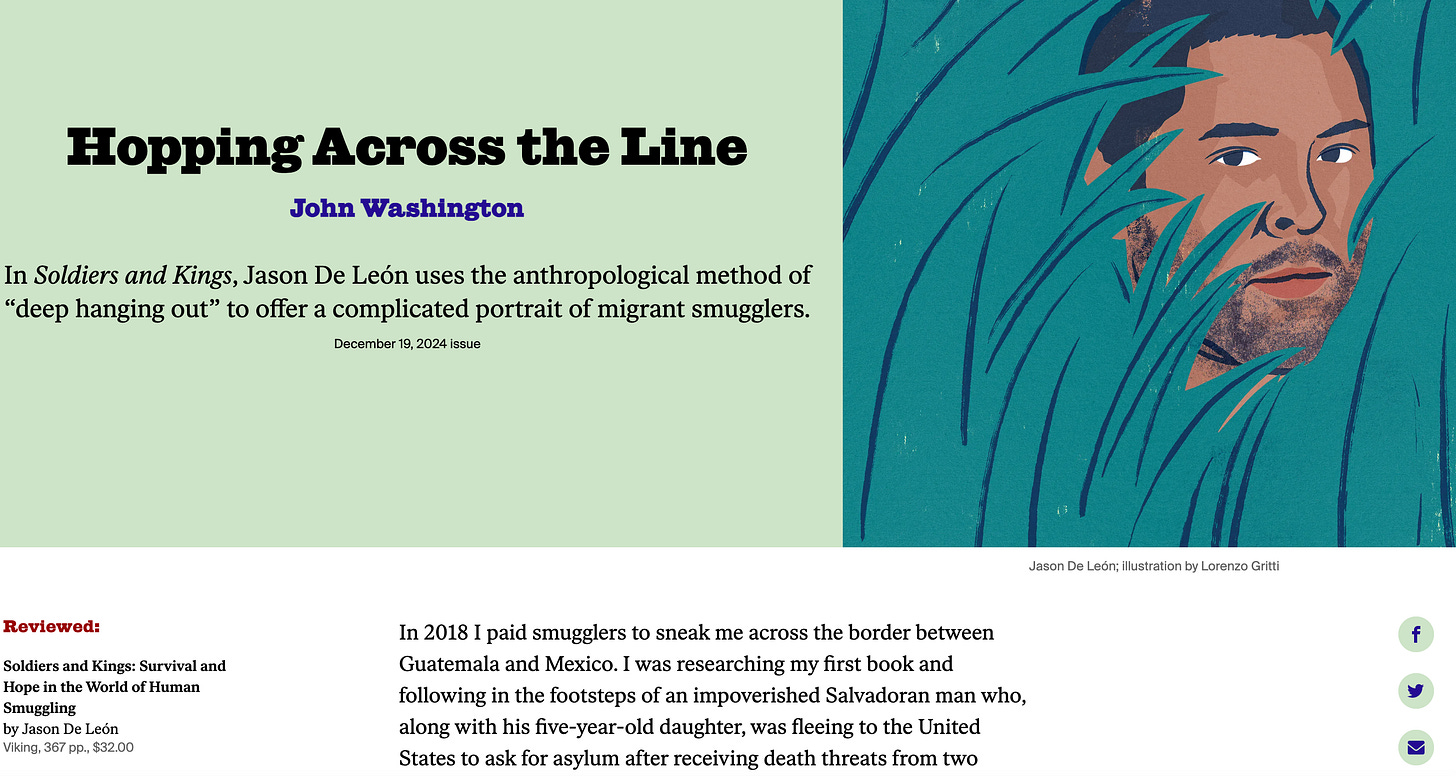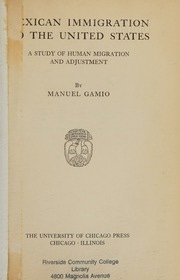Etymologically, the verb to smuggle has German roots, meaning something like to lurk, to creep, or to slip. As with the various etymological shades, there are different sorts of smuggling — drugs, antiquities, exotic pets, succulents, as well as people.
I recently reviewed Soldiers and Kings by Jason De León for New York Review. To research and write the book De León spent years partially embedded with a group of human smugglers in southern Mexico. (De León was recently awarded the National Book Award for his effort.) One point I make in the essay is that there is a lot of misunderstanding, both historical and contemporary, about what human smuggling was and is, how and where it originated, how it is fomented and how it reacts to bordering crackdowns.
One critical point is that despite repeated claims, as one justice department memo recently asserted, that human smugglers are the “worst of the worst,” smuggling wouldn’t exist without the prohibitions that create it. That is one of the key self-fulfilling, vicious, and seemingly endless cycles of border crackdowns and migrant/smuggler criminalization. In medical terms, border policing could be seen as iatrogenic: a case where the intervention is more pernicious than the underlying ailment.

So why does the crackdown strategy persist? I delve into that in the published essay. Here I offer further context on the shifty history of human smuggling.
Some notable smuggling books I touch on:
Soldiers and Kings by Jason De León
Coyotes by Ted Conover
Trade in Strangers by Marianne S. Wokeck
The Snakehead by Patrick Radden Keefe
Clandestine Crossings by David Spener
Migrant, Refugee, Smuggler, Savior by Peter Tinti and Tuesday Reitano
Where the business started
How far back does the practice go? Was Moses a smuggler — as well as one smuggled? Story goes Moses was secreted into Egyptian society and then helped the Israelites escape it. More than a thousand years later (and still thousands of years ago) as documented by the ancient Roman historian Titus Livius in the BCE teens, foreigners sometimes bypassed a rule prohibiting men with children from gaining citizenship by bringing their kids into Rome and selling them as slaves to an amenable citizen. Once the dad was naturalized, the children would be freed by the new citizen who would make the kids citizens as well. Individuals also escaped expulsion from Rome by temporarily entering slavery, prompting a law requiring an oath that someone freeing a slave was not doing so in order to change their citizenship status.
But besides sneaking into city states or conniving to get the imprimatur of an empire, what we consider today to be smuggling only began with the rise of bordered nation states.
Sailors and shipping officers in the colonial era, in addition to their work in the legal transatlantic travel and shipping industry, also acted as coyotes. In Trade in Strangers, Wokeck describes how captains finagled their way around tariffs and restrictions to provide passage to the United States for German and Irish migrants in the early 18th century. Later, early 20th century shipping companies like the Holland America Line had a vested interest in ensuring their passengers would pass strict immigration regulations instead of getting sent back to Europe, and ship employees would doctor entrance questionnaires and instruct passengers on what responses to immigration officials would ensure entry.
In Europe, as immigration scholar Gabriella Sanchez writes, around the end of the 19th century, brokers smuggled foreign children into French factories after the country imposed age-minimums for factory work. “Minors from nearby countries were most often among those smuggled,” Sanchez writes, “as their smugglers were aware that foreign and often fake birth certificates would be less likely to be subject to inspection by the authorities.”
Around the same time, returning to the US-Mexico border, David Spener describes in Clandestine Crossings the rise of what he calls coyotaje, or any use of a paid guide to help a person either cross a border without authorization, assist with labor brokerage or some other form of — as the Roman citizens did when freeing slaves — bureaucratic evasion.
The eye of the orderer
Such coyotaje began in the United States as soon as the first federal immigration restrictions took effect in the late 19th century. Author Erika Lee notes in At America’s Gates that prospective Chinese immigrants in the late 19th and early 20th centuries paid between twenty-three and sixty dollars to enter into the country, often by boat across the Puget Sound. One Chinese migrant who was detained on California’s Angel Island called the form of crossing “the crooked path.” Lee describes smugglers helping Chinese migrants, including thousands of so-called “paper sons” — a sleight of documentation by which legal Chinese immigrants passed off non-relatives as their children to get them into the country — as part of a “highly organized and profitable transnational underground business.”
Decades later, after the establishment of the Border Patrol in 1924, along with new laws limiting migration, Mexican anthropologist Manuel Gamio, in his 1930 book, Mexican Immigration to the United States, documented that coyotes would charge five or ten dollars to help migrants avoid the eighteen-dollar crossing fee at the US southern border. Gamio describes how sometimes smugglers were hired not by the migrants but by industrial farmers, who paid between fifty cents to a dollar per person the smuggler “recruited” and sneaked over the border. “In spite of American and Mexican laws,” Gamio writes, “the smuggling agents are numerous, for the demand for labor pays them well, and even when caught and fined they do not suffer greatly.”
Spener studied migrants’ use of coyotes three-quarters of a century later following the implementation of Border Patrol’s Operation Rio Grande, which was one of a handful of 1990s border crackdowns. According to a 1997 Washington Post article, the strategy was “aimed at crippling the major alien-smuggling rings which have moved their operations to the El Centro area in response to increased enforcement pressure in San Diego.” That’s the precise opposite of what happened.
Spener found that migrants crossing in previous years only used a coyote about twenty percent of the time, whereas migrants who crossed in the years after Operation Rio Grande used a coyote fifty percent of the time. Given the millions of people who crossed the border without authorization in the late 1990s, if those numbers held borderwide, a thirty percent increase in the use of smugglers translates into a few hundred thousand more people forking it over to coyotes.
A decade later, in the late aughts, as I was volunteering with humanitarian aid workers along the Arizona border and writing my first border dispatches, it wasn’t uncommon to hear of people deciding to make the trek on their own. Migrants staging in northern Mexico would tell me of guiding their fellow migrants, often for free, into the deserts. If young men were desperate enough, they’d contemplate going it alone1. Today, fifteen years later, with hundreds of miles of more and higher wall, more surveillance technology blanketing large swathes of the border, and thousands more guards, it’s practically unheard of for someone to strike out on their own.
The pattern holds in trans-Mediterranean migration. The modern-day human smuggling trade in Africa has expanded and solidified in the past decade-plus, really starting to boom with the influx of Syrian refugees seeking passage to Europe, as Tinti and Reitano explain in Migrant, Refugee, Smuggler, Savior.
A combination of Syrians willing to pay a large chunk of their life savings to reach Europe and increasing numbers of African migrants — typically providing less cash but coming in far greater numbers — has made for a bull market in smuggling. While the infrastructure supporting such migrations isn’t new, operations shipping migrants northward in Africa and across the Mediterranean have become integral to local economies. In a rapidly shifting landscape reacting to the power vacuum left by Libyan dictator Muammar Gaddafi — as well as in other destabilized northern African countries — a number of regional ethnic groups have used their role in the smuggling industry to gain political clout. The Berbers, an ethnic group that’s been highly marginalized both during and after the Gaddafi regime, for example, have gained new regional influence by making the city of Zuwarah a desirable route by which to board a boat to Italy.
“A single convoy in the desert creates an ephemeral path that enriches a few,” Tinti and Reitano write. “Repeated a few thousand times, it creates a new order of things.” But with migration, order and disorder are in the eye of the beholder — or the orderer (the state authority).
“The tendency to look at migrant smuggling more as a pathology than as a social phenomenon has thus long influenced the foundational research questions,” Luca Raineri, writing in a chapter of the Routledge Book of Human Smuggling, explains why perhaps the topic hasn't been so seriously assessed outside of academia, despite the fact that human smuggling has persisted for millennia.
The United Nations Protocol against the Smuggling of Migrants by Land, Sea, and Air defines smuggling as “the procurement, to obtain, directly or indirectly, a financial or other material benefit, of the illegal entry of a person into a State Party of which the person is not a national or a permanent resident” (United Nations General Assembly 2000).
As much as that reads like poorly punctuated supranational gobbledygook, there is at least some attempt at precision. Typically, there’s little nuance in how smugglers are portrayed and prosecuted. The European Commission, in announcing late last year a new “global alliance” to combat smuggling, declared that “migrant smuggling is a criminal activity that disrespects human life.”
In practice, plenty of smugglers likely do disrespect human life, but that is the cost many migrants pay in order to seek or save their own lives.
(For years now, I’ve been tossing around the idea to do a book on the history and current practice of human smuggling. If you want to fund two years of research and reporting, my DMs are open.)
Alice Wanamaker contributed research to this article.
While it was extremely rare for a migrant woman to decide to make a solo crossing, women do play key but distinct roles in the business of smuggling. Scholars Stephanie Leutert and Maureen Rendón in a recent issue of the Journal of Borderlands Studies dive into the demographics of coyotaje at various smuggling stages, explaining how female guides (often overlooked in popular understandings of migrants’ journeys) can be integral in helping people cross at ports of entry or in picking them up after they’ve already made the crossing.



